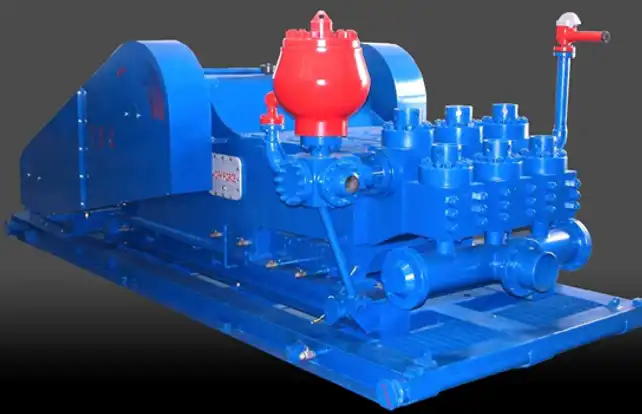Fluid end: Heart of mud circulation
The fluid end is often referred to as the heart of a mud pump, as it directly interacts with the drilling fluid. This section is responsible for the actual pumping action, moving mud through the system at high pressures. Let's examine the key components that make up the fluid end:
Piston and liner assembly
At the core of the fluid end is the piston and liner assembly. The piston moves back and forth within the liner, creating the pumping action. This assembly is designed to withstand the abrasive nature of drilling fluids and maintain a tight seal to ensure efficient pumping.
Valves and seats
Mud pumps typically utilize two types of valves: suction and discharge. These valves work in tandem to control the flow of drilling fluid through the pump. The suction valve opens to allow mud to enter the fluid end, while the discharge valve opens to expel the pressurized fluid into the drilling system.
Fluid end module
The fluid end module houses all the aforementioned components. It's typically made of high-strength materials to withstand the extreme pressures and abrasive nature of drilling fluids. The module also includes various seals and gaskets to prevent leaks and maintain pressure integrity.
Power end: Driving force behind pumping
While the fluid end handles the actual pumping, the power end provides the mechanical energy necessary to drive the process. This section converts rotational energy from the pump's power source into the reciprocating motion required for pumping. Let's explore the key components of the power end:
Crankshaft and connecting rods
The crankshaft is the primary component of the power end. It rotates to convert the input energy into reciprocating motion. Connected to the crankshaft are the connecting rods, which transfer this motion to the crossheads and ultimately to the pistons in the fluid end.
Crossheads and guides
Crossheads act as a link between the connecting rods and the pistons. They move along guides, ensuring smooth and aligned motion. This assembly helps distribute the load and reduces wear on the pistons and liners.
Gear reduction system
Many mud pumps incorporate a gear reduction system in the power end. This system allows the pump to operate at optimal speeds while accommodating various input power sources, such as electric motors or diesel engines.
Maintenance tips for pump longevity
Proper maintenance is crucial for ensuring the longevity and efficiency of mud pumps. Here are some essential tips to keep your pump operating at peak performance:
Regular inspections and cleaning
Regular inspections are essential to maintain the efficiency and longevity of mud pumps. Both the fluid and power ends should be thoroughly checked for signs of wear, leaks, or damage, as these can affect performance and safety. Additionally, routine cleaning is critical to prevent the accumulation of drilling mud, debris, and other contaminants. This buildup can hinder the pump's operation, increase wear, and reduce efficiency. By keeping the components clean and well-maintained, you ensure smoother operations and longer service life for the equipment.
Lubrication management
Proper lubrication is crucial for the smooth operation of the power end of a mud pump. Regularly monitoring oil levels is essential to prevent friction and overheating of internal components. It's also important to follow the mud pump supplier's guidelines for oil change intervals to ensure optimal performance. Using high-quality lubricants specifically designed for the harsh conditions of mud pump operations can prevent wear and extend the lifespan of the equipment, ensuring reliable and consistent performance during drilling operations.
Wear part replacement
Mud pump components such as pistons, liners, and valves are prone to wear due to the abrasive nature of drilling fluids. To prevent unexpected failures and minimize downtime, it is vital to implement a proactive replacement schedule based on operating hours or regular inspections. This ensures that any worn or damaged parts are replaced promptly before they cause more significant issues. By staying ahead of wear and tear, you can maintain the pump's efficiency and reliability, reducing the risk of costly repairs and interruptions during drilling operations.
Conclusion
Understanding the key components of a mud pump's fluid and power ends is essential for anyone involved in drilling operations. The fluid end, with its pistons, valves, and module, handles the direct interaction with drilling fluids. The power end, comprising the crankshaft, connecting rods, and crossheads, provides the necessary mechanical force. By grasping the functions and interactions of these components, operators can better maintain their equipment and optimize drilling performance. Remember, regular maintenance and timely replacement of wear parts are crucial for maximizing the lifespan and efficiency of your mud pump.
Optimize Your Drilling Operations with CM Energy's Advanced Mud Pumps
When it comes to reliable and efficient mud pumps, CM Energy's TSC brand stands out as a leader in the industry. Our WF Series mud pumps offer compact designs, high efficiency, and robust performance for demanding drilling applications. With a global network of support and customizable solutions, we ensure your operations run smoothly and productively. Experience the difference of TSC mud pumps – contact our experts today at info.cn@cm-energy.com to find the perfect mud pump solution for your needs.
References
- Johnson, R. (2023). Advancements in Mud Pump Technology for Modern Drilling Operations. Journal of Petroleum Engineering, 45(3), 178-192.
- Smith, A. & Brown, T. (2022). Comprehensive Guide to Mud Pump Maintenance and Troubleshooting. Drilling Contractor's Handbook, 7th Edition.
- Thompson, E. (2024). Fluid End Design Innovations: Improving Efficiency and Longevity in Mud Pumps. International Journal of Drilling Science, 12(2), 89-103.
- Garcia, M. et al. (2023). Power End Optimization for High-Pressure Mud Pump Applications. Society of Petroleum Engineers Conference Proceedings, SPE-2023-0789.
- Williams, K. (2022). Material Advancements in Mud Pump Components: Enhancing Durability and Performance. Materials Science in Drilling Equipment, 18(4), 412-426.
- Lee, S. & Park, J. (2024). Comparative Analysis of Mud Pump Designs: Impact on Drilling Efficiency and Cost-Effectiveness. Offshore Technology Conference, OTC-2024-31567.


